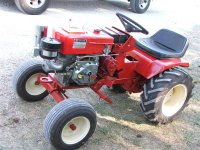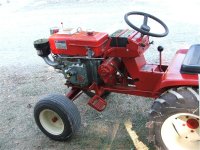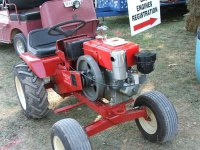Billbill1, Blackbird: The gasser is AIR COOLED and the Yanmar is water cooled. The radiator comes with it, a special aluminum unit that mounts on top of the engine since it is a vertical shaft engine.
Mossroad: Regarding the batteries, tires, carb, etc; as another member has mentioned, most of these consumer products don't have longevity in mind. While the quality of these tractors do go up from lawn tractors (not rated for ground engaging work) to the garden tractors (transaxle rated for ground engaging work), some things don't change. These are the tires (thin skinned components made by Carlisle that leak air like a sieve). Once they go flat, the sidewalls have so little support that they distort and separate from rims which makes them even less likely to hold air. While inner tubes would reduce this somewhat, I fixed the problem with aftermarket tires that were much thicker. When I compared both tires off the rims, the difference in quality was readily apparent. The battery issue: The OEM calls for lawn equipment batteries that are not very good quality. They have low capacity and don't hold charges very well. They self discharge over time and as with most lead acid batteries, when they remain discharge for any significant period of time, they are dead-dead. I've tried to revive many but have never had any success. One website that rates batteries based of type considers the life of these to be 1-2 years. I fixed the problem on mine by replacing/modifyig the tray to accommodate a full size auto battery and then went one step further with the optima. It has been 5 years now and the battery shows no signs of weakening. I also let it sit in the tractor the entire offseason and the battery shows no evidence of self discharge. It starts up strong each spring. As for the carburetor issue, regardless if it is briggs or kohler, I've never had good luck with them. I've rebuilt them several times now and the last time around, the fuel cutoff solenoid began sticking causing constant flooding (which literally meant that the gas was pouring out of carb) and wouldn't stop until I pinched off the line. That time around, the carb needed replacement and that was NOT CHEAP. Some of the problems could be contributed to the fuel itself not winterizing well and causing a bunch of problems but I figure that the high pressure of the diesel injection system will have less problems with offseason storage. Many folks report that their diesels start right up after periods of very long storage.
Anyhow, I figured I fixed almost everything else to my liking. This might be the last link. Oh, BTW in case anyone is wondering: I've had zero problems with the transaxle and mower in the past 10 years. A few broken or tossed belts but some of it my fault for not keeping the mower deck clean/maintained.






